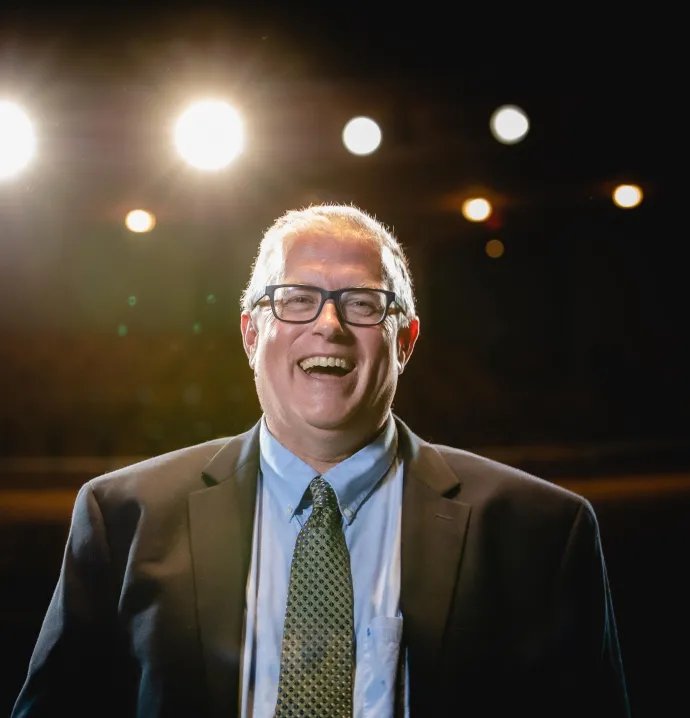An electronics revolution
An electronics revolution
The word “spintronics” may not be a household name, but it has the potential to revolutionize the electronic devices we use every day.
This emerging field of spintronics is something the University of Northern Iowa Department of Physics has been studying for years. And with a new $236,000 grant from the National Science Foundation, that research will continue to advance the field. Spintronics harnesses the spin of electrons to magnetically store and process data, which could potentially multiply the storage capacity of electronic devices while boosting devices’ speed and energy efficiency.
“It's fair to say that spintronics is maybe one of the biggest developments in material science in the last few years, maybe the last couple decades,” said Pavel Lukashev (pictured on the right), professor in the department of physics, who is helping lead the investigation of new materials that may possess the necessary magnetic and electronic properties for large scale development of new spintronic devices, such as hard drives and data storage devices in computers and cell phones.
The project is a collaborative work between UNI and South Dakota State University. Lukashev will act as the principal investigator in the research, alongside co-principal investigator Paul Shand, head of the department of physics at UNI.
But what is spintronics? Put simply, it’s a new branch of electronics that combines magnetic properties with semiconductor technology. And to understand it, it’s important to understand two things: spin-polarized current and materials that are capable of producing it, such as half-metals, which will be the focus of UNI’s research.
As Lukashev explains it, all electrons have two types of something called “spin,” which is often visualized as analogous to the Earth spinning on its axis. In regular electric current, like the type that runs into households, the number of electrons with one type of spin is nearly equal to the number with the other.
Spintronics is different. The spintronics version of electric current has a number of electrons with one spin that far exceeds the number of electrons with the other. This is called spin-polarized current. It is far more energy efficient in the storage of data than normal current, but its generation is one of the biggest challenges in the field, Lukashev said.
Spin-polarized current could be achieved with materials known as half-metals, which are conductors of electrons with one type of spin and insulators for the other.
With the NSF grant funding, researchers at South Dakota State University will be fabricating half-metals and sending them to Lukashev and Shand who, along with a team of students, will test the materials.
“We will be looking for materials that have very promising electronic and magnetic properties for device applications,” Lukashev said. “We will suggest which materials have the best potential application for devices and also describe the material’s properties.”
About four or five UNI students will also be involved in the research each year, which will fill undergraduate research requirements that are both necessary for their degree and hallmarks of the UNI program.
 “Undergraduates get the opportunity to be involved in research of very high caliber and many end up with publications in respected journals,” Shand, pictured to the left, said.
“Undergraduates get the opportunity to be involved in research of very high caliber and many end up with publications in respected journals,” Shand, pictured to the left, said.
In spintronics research, students have the chance to both work in the lab and use some of the most powerful computers in the country to analyze the half-metals.
“Students will be involved in all aspects of the experimental work that I will do,” Shand said. “They will be making sure that we have samples of the correct size, mounting the samples, placing the samples inside of the measuring chamber, making the actual measurements and writing programs to make the measurements. And then they'll be involved in data analysis and writing papers describing our research results.”
Students will also remotely access two offsite supercomputers, one called “Bridges” located at the Pittsburgh Supercomputing Center and the other a computer cluster at the Center for Functional Nanomaterials, at Brookhaven National Laboratory in Upton, New York.
“Students find it fascinating that they can do research on a computer hundreds of miles away from their local coffee shop,” Lukashev said. “It gets them very excited about this type of research.”
Lukashev’s research has been underway for several years – with his team publishing more than a dozen scientific papers on the topic. And the grant will ensure this work will continue, and that UNI students will continue to reap the benefits of the research experience.
“There is a huge amount of potential in spintronics, which is why a lot of people are working on it,” Shand said. “Students have a real sense of involvement in the discovery process. And so we're trying to do a little bit to move the field forward.”




